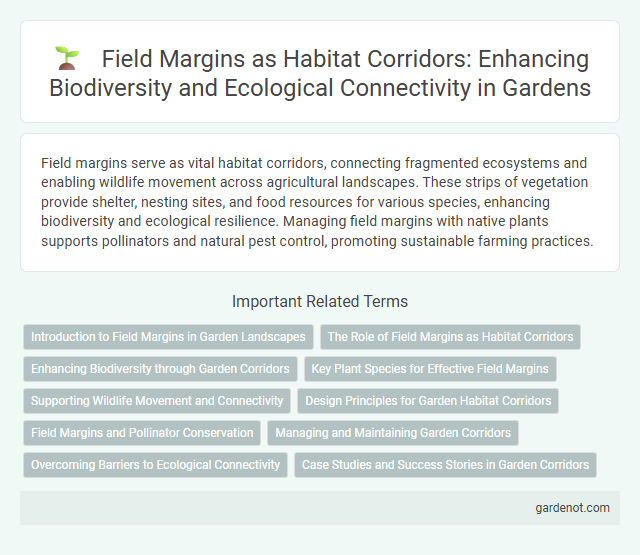Field margins serve as vital habitat corridors, connecting fragmented ecosystems and enabling wildlife movement across agricultural landscapes. These strips of vegetation provide shelter, nesting sites, and food resources for various species, enhancing biodiversity and ecological resilience. Managing field margins with native plants supports pollinators and natural pest control, promoting sustainable farming practices.
Introduction to Field Margins in Garden Landscapes
Field margins in garden landscapes act as vital habitat corridors, enhancing biodiversity by connecting fragmented wildlife areas. These strips of vegetation provide essential resources such as food, shelter, and nesting sites for pollinators, birds, and beneficial insects. Incorporating native plants and diverse flora in field margins supports ecosystem resilience and promotes natural pest control.
The Role of Field Margins as Habitat Corridors
Field margins serve as vital habitat corridors by connecting fragmented landscapes, facilitating wildlife movement and genetic exchange between isolated populations. These narrow strips of vegetation enhance biodiversity by providing food resources, shelter, and breeding grounds for insects, birds, and small mammals. Maintaining and restoring field margins supports ecosystem resilience and promotes sustainable agricultural practices by integrating conservation into productive land.
Enhancing Biodiversity through Garden Corridors
Field margins serve as vital habitat corridors that enhance biodiversity by connecting fragmented garden ecosystems and supporting wildlife movement. These strips of vegetation provide essential resources such as food, shelter, and nesting sites for pollinators, birds, and beneficial insects. Integrating native plants and minimizing pesticide use within garden corridors amplifies ecological resilience and species diversity.
Key Plant Species for Effective Field Margins
Key plant species for effective field margins include native grasses like Festuca rubra and wildflowers such as Centaurea nigra and Achillea millefolium, which support pollinators and beneficial insects. Incorporating nitrogen-fixing plants like Trifolium pratense enhances soil fertility and promotes biodiversity. Diverse plant species create habitat connectivity, improving the ecological function of habitat corridors.
Supporting Wildlife Movement and Connectivity
Field margins serve as vital habitat corridors that enhance wildlife movement and connectivity across agricultural landscapes. By providing continuous strips of vegetation, these margins offer shelter, food resources, and safe passage for pollinators, small mammals, and birds, facilitating gene flow and population stability. Effective management of field margins improves biodiversity, supports ecosystem services, and mitigates habitat fragmentation impacts.
Design Principles for Garden Habitat Corridors
Field margins designed for garden habitat corridors maximize biodiversity by incorporating native plant species that provide continuous cover and food sources for pollinators and wildlife. Strategic placement of buffer strips with layered vegetation creates connectivity between fragmented habitats, facilitating species movement and gene flow. Emphasizing structural diversity and avoiding pesticide use ensures a resilient corridor that supports ecological functions and enhances overall landscape health.
Field Margins and Pollinator Conservation
Field margins serve as crucial habitats that enhance pollinator conservation by providing diverse floral resources and nesting sites, supporting species such as bees, butterflies, and hoverflies. These strips of vegetation along agricultural fields increase biodiversity, improve crop pollination, and contribute to ecosystem resilience. Maintaining diverse field margins rich in native wildflowers can significantly boost pollinator populations and promote sustainable agricultural practices.
Managing and Maintaining Garden Corridors
Field margins serve as essential habitat corridors by providing continuous shelter and resources for wildlife movement between fragmented natural areas. Managing these corridors involves regular mowing schedules that avoid peak nesting seasons and the selective removal of invasive species to preserve native plant diversity. Maintaining garden corridors also requires soil health monitoring and the integration of pollinator-friendly plants to enhance biodiversity and ecosystem resilience.
Overcoming Barriers to Ecological Connectivity
Field margins serve as critical habitat corridors that help overcome barriers to ecological connectivity by providing continuous strips of vegetation between isolated habitats. These margins facilitate the movement of pollinators, small mammals, and other wildlife, enhancing gene flow and biodiversity across fragmented agricultural landscapes. Establishing diverse, native plant species in field margins improves structural complexity and reduces edge effects, supporting species migration and ecosystem resilience.
Case Studies and Success Stories in Garden Corridors
Field margin garden corridors have demonstrated increased biodiversity and improved pollinator activity in various case studies. Research from the UK revealed that native wildflower strips along field margins boosted bee populations by 40%, enhancing crop pollination and yield. Success stories from France highlight how integrating shrubs and hedgerows in garden corridors facilitates wildlife movement and increases habitat connectivity.
Field margin Infographic

 gardenot.com
gardenot.com